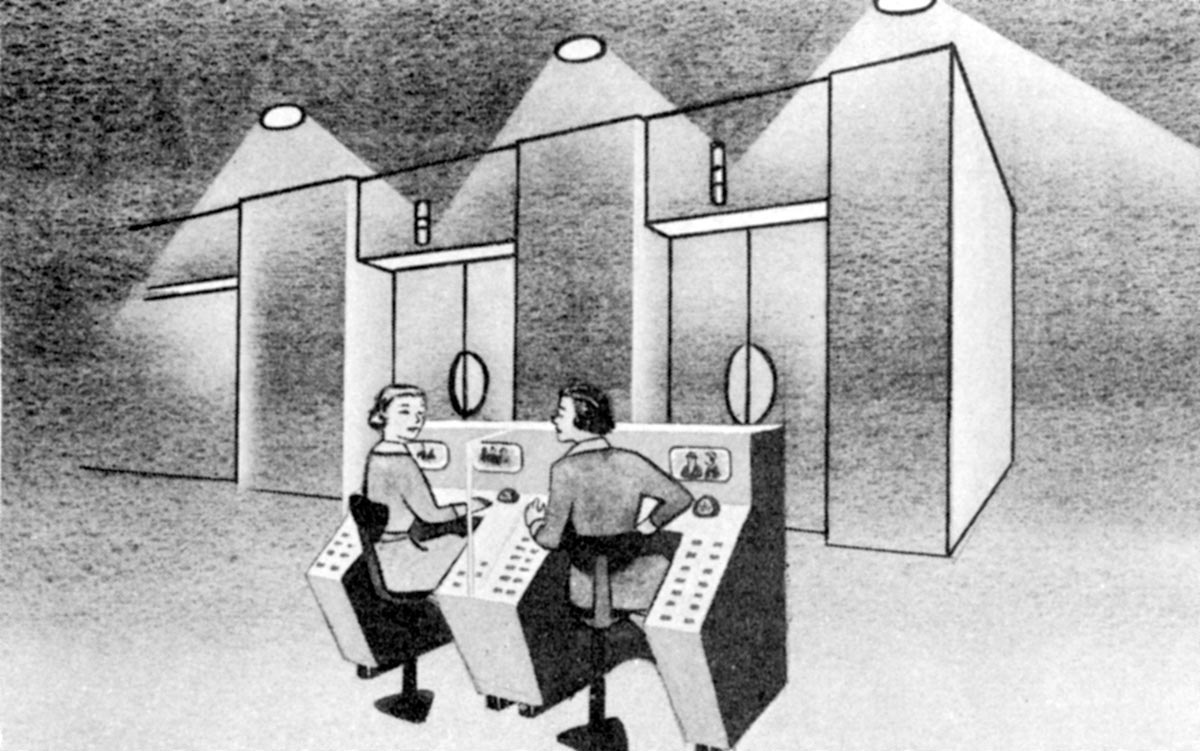1950s Innovations in Elevator Cab Design
Apr 1, 2021

This History article examines cabin-access innovations that arose from the development of operator-less elevators in the early 1950s.
The founding of Elevator World, Inc. in 1953 coincided with the introduction of the modern operator-less elevator. This fundamental shift in elevator operation and use was addressed in numerous articles throughout the 1950s. A consistent theme explored by authors was how to provide efficient and safe elevator operation in the absence of an operator. Much of the discussion centered on proposed innovations in cab design and cab access systems.
One of the first articles to address these issues also serves as a reminder that Elevator World was not the only important vertical-transportation (VT) business venture launched in the mid-20th century. The July 1953 issue included an article by Charles W. Lerch named, “Help Yourself to Operatorless Elevators.” The name “Lerch” is, of course, well known in the VT world. Charles W. Lerch began his career with Otis. In 1947, he left and established C.W. Lerch Co in Chicago. In 1964, he partnered with Quentin Bates to found Lerch Bates. In the early 1950s, the innovative spirit that would infuse his future business was evident in his thoughtful appraisal of operator-less elevator systems and in his own inventions, one of which was the subject of an ELEVATOR WORLD, August 1953 article titled, “Another Assist for Operatorless Elevators with Invention of Caution Lights.”
In May 1953, Lerch filed a patent application for a system designed to alert waiting passengers if, when a cab arrived, riders would be exiting. The introduction of “Elevator Signaling Apparatus,” U.S. Patent No. 2,730,693 (January 10, 1956), was:
“Automatic and semi-automatic elevators are rapidly increasing in popularity. Generally speaking, thanks to the automatic-control mechanisms heretofore invented by persons working in the elevator art, such elevators are as fast in operation as manually operated elevators and are substantially safer, since door operation, floor leveling, etc. are accomplished without being dependent on fallible human judgment. One important problem encountered in the operation of automatic and semi-automatic elevators, however, is the problem of traffic congestion at floor stops. Frequently, persons seeking to enter a car at a particular floor find themselves traveling cross-current to passengers on the car who are seeking to leave it, with confusion and delay. The primary object of the present invention is to solve that problem by providing novel automatic means for warning persons at a floor stop when passengers on the car will be debarking. Thus warned, the persons waiting at the floor stop can stand clear of the doors and give the debarking passengers an opportunity to get off the car before the waiting passengers enter it.”[1]
The operation of Lerch’s caution light system involved:
“. . .providing on each floor a distinctive signal, which may, for example, be a light accompanying the usual ‘up-down’ indicator lights. That distinctive signal, which might be called the ‘debarkation signal,’ is automatically actuated on a given floor whenever the car stops at that floor responsively to a signal initiated from within the car. Thus, a passenger desiring to use the car to ride upward from his floor will press the call button in the hallway in the usual manner. If, when the car arrives, no passenger is to get off, the customary ‘up’ light will flash, announcing the arrival of the car. If passengers are to debark from the car at that floor, the usual ‘up’ light will flash, and, in addition the debarkation signal will be actuated, thus announcing the arrival of the car and warning the waiting persons that they must afford clearance for debarking passengers before boarding the car themselves.”[1]
Although the EW article only addressed the caution light, in his patent, Lerch had also noted that “the debarkation signal may be a bell or buzzer, or it may consist of an automatic recording playing through a loudspeaker and announcing a suitable warning such as, ‘Please stand back, passengers will be leaving the car.’”[1] The patent drawings included a depiction of an elevator system with the caution lights placed between the up and down arrows in a panel centered above the cab entrance and an “automatic selector mechanism” that served as the “control selector” for his signaling system (Figures 1 and 2).
EW’s February 1954 issue announced the installation of the first caution light system in the 12-story South Texas Corp. Building in San Antonio, Texas. The building’s elevator system was being modernized, and the addition of the light system was viewed as an important aspect of the work. The caution light fixture, designed by Price Brothers, Inc. of Chicago, was centered over the cab entrance and, when needed, flashed the word “OUT” “like a blue neon sign” (Figure 3).[2] C. Cedric Wenger, president of the corporation, was quoted as saying, “The new signal should make a measurable improvement in elevator service. Actual performance of this installation will be closely observed to determine the utility of the ‘OUT’ light for other elevator systems.”[2] Unfortunately, nothing else is known about this installation or if other caution light systems were installed.
Lerch’s application for his cab exiting signaling system was, in fact, one of two patent applications he filed in 1953. Although the other was not the subject of an EW article, it also concerned operator-less cab design: “Automatic Control Mechanism for Elevators,” U.S. Patent No. 2,713,645 (July 19, 1955). The design concerned a means for “automatically rejecting floor-stop signals in an automatic elevator system at times when the car is loaded to capacity.”[3] Once again, this design was placed in the context of the transition to operator-less elevators:
“In the early stages of development of electrical elevator controls, the actual acts of starting and stopping the elevator car were invariably performed by a human operator under the guidance of signals, such as buzzer or light signals, automatically transmitted to the car responsively to manual actuation of buttons situated on the various floors served by the car. In such relatively simple elevator installations, the operator was normally free to respond to or ignore floor-stop signals, subject only to whatever supervision might be exercised by the elevator starter. When, in making a down trip, for example, the elevator became filled to capacity; at an intermediate floor, the operator could proceed directly to the main floor, either ignoring subsequent stop signals or operating a manual switch within the car to make his own signal panel unresponsive to such signals.”[3]
Lerch acknowledged that systems had been developed that were “responsive to the weight being carried by the elevator” which caused the cab “to reject floor-stop signals after the weight exceeds a certain critical value.”[3] However, he claimed that these systems had “not been particularly satisfactory, due primarily to the fact that weights of passengers vary so greatly and to the fact that weight-responsive mechanisms are difficult to keep in good condition to provide accurate operation.”[3]
His solution was to ignore passenger weight and focus instead on the “occupancy of floor space in the car” as the factor that determined when an elevator would “reject floor-stop signals.” Lerch’s design employed a raised floor system composed of a series of square panels, which rested on springs. Adjacent to each spring was a “micro-switch” that functioned as a stop limit:
“A person entering the elevator car will have the sensation of walking on a slightly yieldable, springy floor. When he takes up his standing position within the car, his feet will be resting on one or more of the individual panels and will force them downward against the force of the springs until they are brought to rest on limit members.”[3]
When most micro-switches were activated, the car would automatically ignore additional floor-stop calls. Interestingly, although the system was designed for operator-less elevators, Lerch’s patent drawings depicted an operator (Figures 4-6).
Another early EW article on cab innovations appeared in May 1954: “Telestarter Gives New Look into the Future” discussed a control system recently patented by Joshua E. Shirley: “Remote-Control System for Cars Moving in a Defined Path of Travel,” U.S. Patent No. 2,602,524 (July 8, 1952). Shirley, an Otis construction supervisor, had filed his application in May 1950, just as the first operator-less elevators were beginning to appear. However, rather than embracing them as the future of VT systems, he was clearly skeptical of their potential, claiming that, while operator-less elevators were “useful in some instances,” they were “not practical in office buildings. . . where the elevator traffic is quite heavy.”[4] At the same time, he recognized that the presence of the operator reduced the amount of space available for passengers. His solution was to replace the operator with a closed-circuit TV system. Each cab would be equipped with a camera focused on the car entrance and a two-way communication system (Figure 7). The elevator operator(s) was (were) stationed at a control console, preferably on the first floor, where they monitored elevator traffic (Figures 8 and 9). When passengers entered a cab, the operator(s) would ask their destination, press the appropriate button on the console and dispatch the cab.
Shirley, who lived in the Philadelphia suburb of North Hills, attracted the attention of The Philadelphia Inquirer, which described his invention and its origin:
“Having worked at elevator installations for 35 of his 54 years, Shirley knows all the tricks of vertical travel. ‘But the idea for this device didn’t come to me while I was working on elevators,’ he admits. ‘It hit me one night while I was attending a hobby show. There were TV cameras spotted around the floor picking out visitors and showing them to themselves on monitor screens. I can’t describe the exact mental process, but before I knew it, my mind carried this TV eye into an elevator, where it would see everything but take up no room.”[5]
The newspaper’s author concluded his article by noting:
“Elevator operators remain unconcerned by these developments. They feel that it will be many, many years before automatic lifts will replace them. Meanwhile, they’re far more concerned about the riders who push the up button when they want to go down. ‘If you had a device that would eliminate that,’ they said, ‘you’d really have something.’”[5]
While the elevator operators’ optimism regarding their job security was somewhat misplaced, their observation about passenger behavior – and passengers’ understanding of elevator operation – serves as a reminder that some design challenges transcend both time and changes in operating systems.
References
[1] Charles W. Lerch. “Elevator Signaling Apparatus,” U.S. Patent No. 2,730,693 (January 10, 1956).
[2] Untitled news brief. ELEVATOR WORLD, February 1954.
[3] Charles W. Lerch. “Automatic Control Mechanism for Elevators,” U.S. Patent No. 2,713,645 (July 19, 1955).
[4] Joshua E. Shirley. “Remote-Control System for Cars Moving in a Defined Path of Travel,” U.S. Patent No. 2,602,524 (July 8, 1952).
[5] Ray Millton. “Televators Are Next,” The Philadelphia Inquirer, December 7, 1952.
Get more of Elevator World. Sign up for our free e-newsletter.









